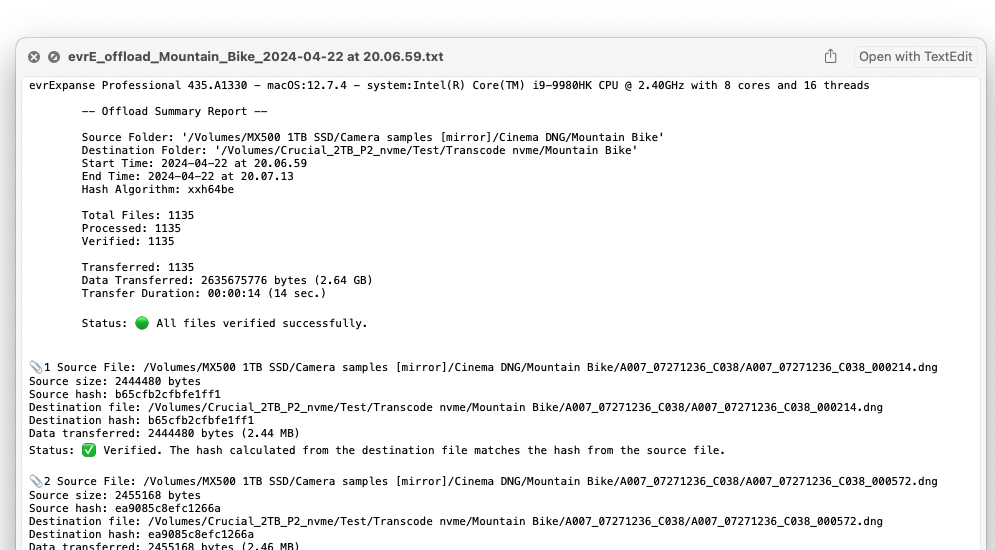evrExpanse User Manual v.5.6.4 - updated May 28, 2025
Table of Contents
- Installation
- How to use
- Preferences
- Media Files and Camera Specifications
- How to import CSV file in DaVinci Resolve
- How to import in Final Cut Pro
- How to import in Assimilate Scratch
- How to import ALE file in Avid Media Composer
- How to import CSV file in Silverstack
- Canon XF Utility Integration Workflow
Installation
How to Install evrExpanse
Open the DMG file and drag & drop evrExpanse.app to the Applications folder.
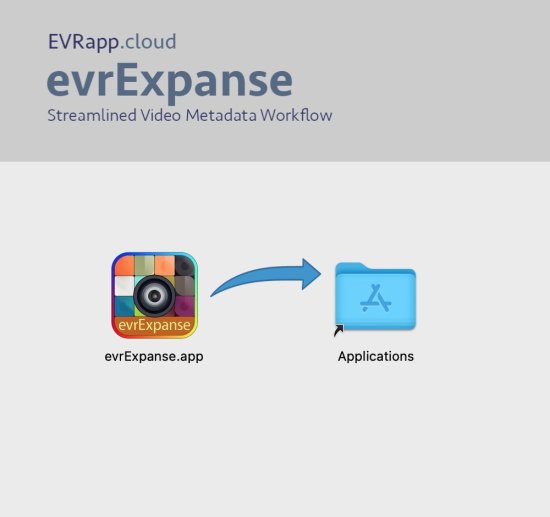
Uninstalling evrExpanse
- Locate the evrExpanse application in the /Applications folder.
- Drag the evrExpanse.app file to the Trash bin.
- Alternatively, you can right-click on the evrExpanse.app file and select "Move to Bin."
Please note that uninstalling evrExpanse will remove the application from your system while retaining the application preferences.
Grant Permissions
To ensure evrExpanse functions properly, you need to grant it the required permissions in macOS System Preferences. These permissions are necessary for evrExpanse to access required system features such as file management, user interactions, and automation tasks. If permissions are not granted, certain features of evrExpanse may not function as expected.
If these permissions are not already set, proceed with the steps below to configure Full Disk Access, Accessibility Permission, and Automation Permission.
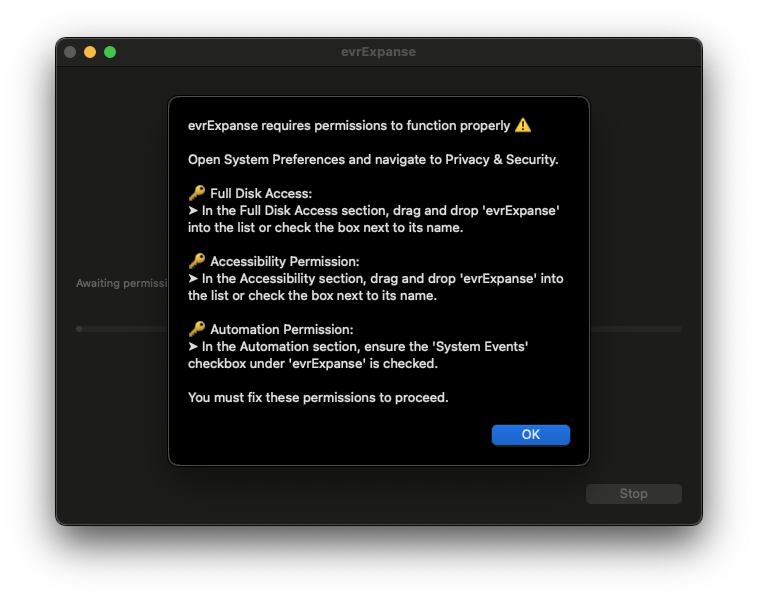
1. Full Disk Access
- Open System Preferences → Privacy & Security → Full Disk Access.
- Click the lock (if necessary) and enter your admin password.
- Drag and drop evrExpanse into the list, or check the box next to its name.
2. Accessibility Permission
- Go to Privacy & Security → Accessibility.
- Click the lock and authenticate if needed.
- Drag evrExpanse into the list, or check the box next to its name.
3. Automation Permission
- Go to Privacy & Security → Automation.
- Under evrExpanse, check the box for System Events.
Activating the License
Open the evrExpanse application, a startup window will open.
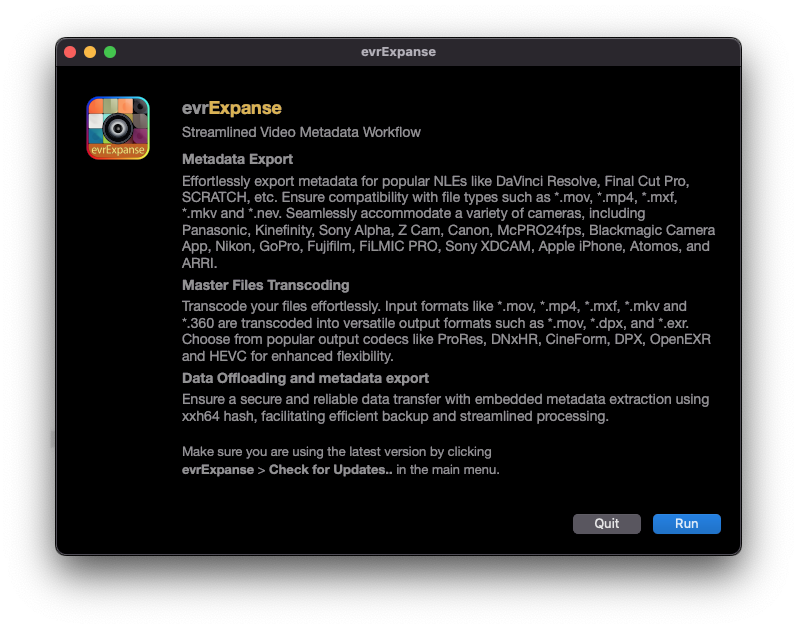
Upon clicking the Run button, a pop-up window will appear.
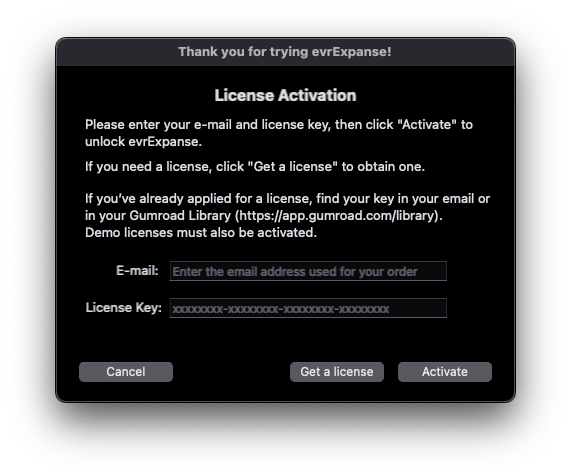
If you have a license key, please enter it along with the email address used for the purchase, then click Activate. Demo licenses also require activation.
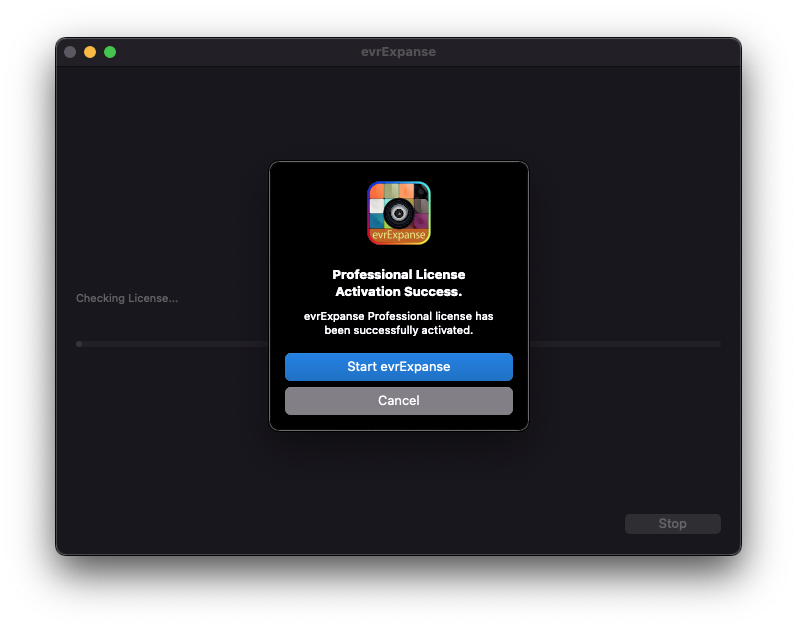
If the inserted license key is validated, a message confirming the successful validation will appear.
Deactivating the License
Deactivating a license is an essential step, particularly during an upgrade from a type of license to another one. This process seamlessly reverts evrExpanse to its initial state, prompting users to activate a new license upon startup.
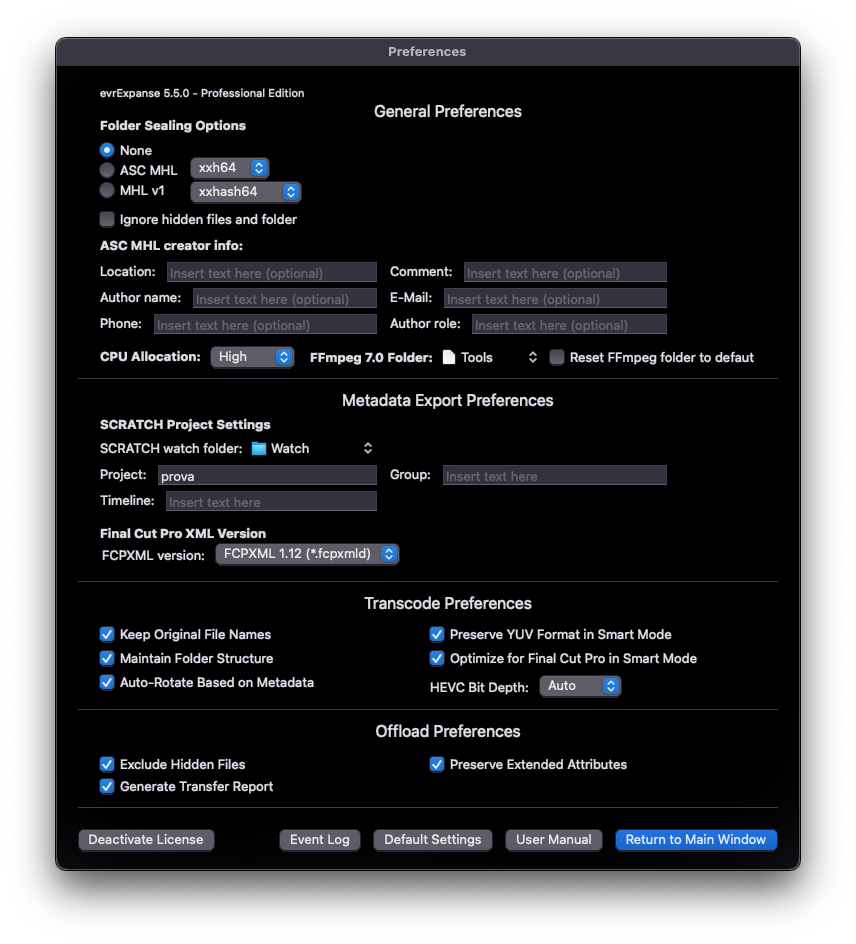
To deactivate the license, follow these simple steps:
- Open the Preference panel in the application.
- Locate the "Deactivate License" button.
- Click on the "Deactivate License" button.
- A confirmation message will appear, asking if you want to proceed.
- After confirming your decision, a new message will appear, confirming the successful deactivation of the license.

Deactivating the license will revert it to an unactivated state, removing access to all premium features and benefits of the licensed version.
How to use

After clicking the Run button the main window will pop up.
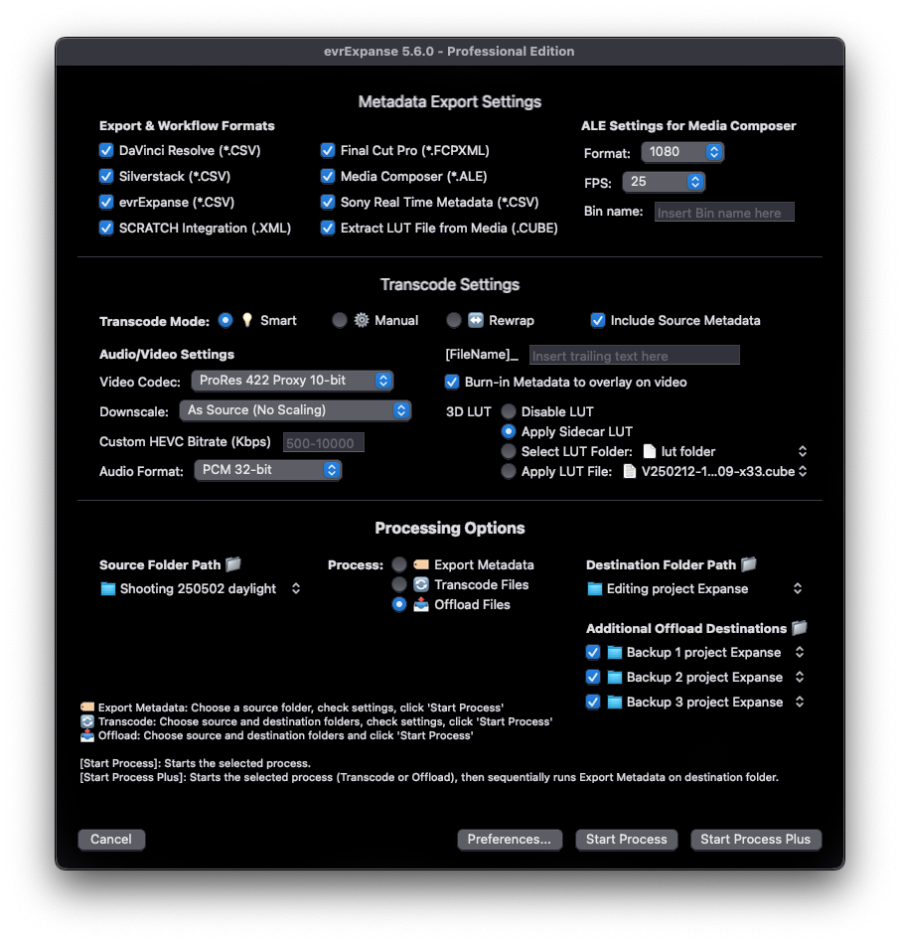
Media Workflows
evrExpanse offers flexible tools to manage key stages of your media pipeline. You can run each process independently or combine them using Process Plus for a streamlined, integrated workflow.
Metadata Export
Extract metadata from a variety of sources—including multiple camera types—and import it into NLEs such as Final Cut Pro®, DaVinci Resolve®, Avid Media Composer®, Assimilate SCRATCH®, and Pomfort Silverstack®. This enhances metadata management and improves editorial workflows.
Transcode Master Files
Convert source files into intermediate codecs such as ProRes®, DNxHR®, GoPro CineForm®, HEVC (H.265), DPX®, or OpenEXR®, with support for MOV, MP4, MXF, and MKV containers. Embedded metadata and Finder Tags are preserved for seamless integration downstream.
Offload Data
Securely transfer and back up media using the xxh64 checksum to verify data integrity. This ensures your assets are safely offloaded and backed up.
Process Plus: Automate and Integrate
Use Process Plus to combine Transcode + Metadata Export or Offload + Metadata Export in one action, improving efficiency and maintaining metadata continuity throughout. This feature processes the files and then automatically exports the corresponding metadata. Ensure all transcoding/offloading and metadata settings are properly configured beforehand. The metadata export destination will match the output folder defined in your process settings.
Transcode, Offload, and Metadata Integration Workflow
In workflows where transcoding or offloading must occur before metadata import into NLEs, follow these steps:
Start with Transcoding or Offloading your master files.
Run Metadata Export on the processed files to ensure all metadata is correctly included.
Alternatively, use Process Plus to combine these steps into one seamless action.
Zero-Byte File Alert
Before any process begins, evrExpanse scans for and alerts you to any zero-byte files, which can indicate corruption or incomplete transfers. This safeguard applies to Transcode, Metadata Export, and Offload workflows.
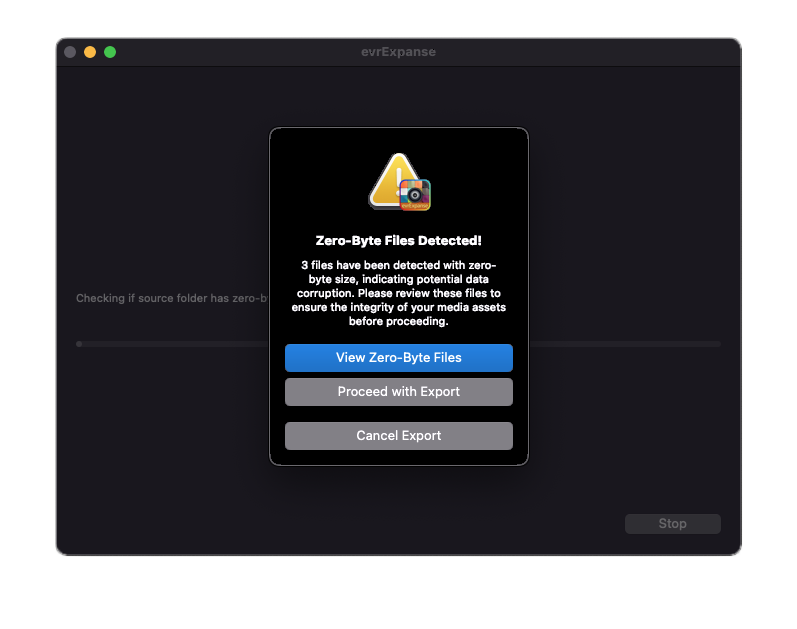
Alerts are triggered before processing begins.
You can click “View Zero-Byte Files” to open a TextEdit document listing all affected file paths.
The tool continuously monitors for zero-byte files and includes them in the final report.
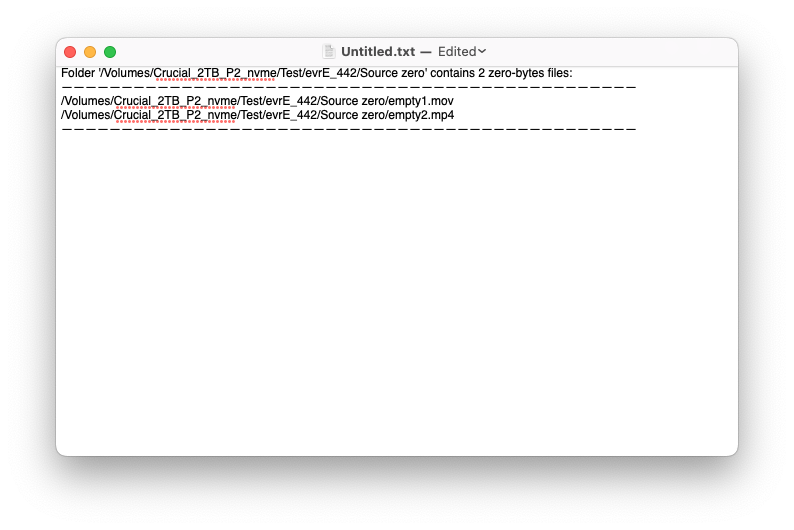
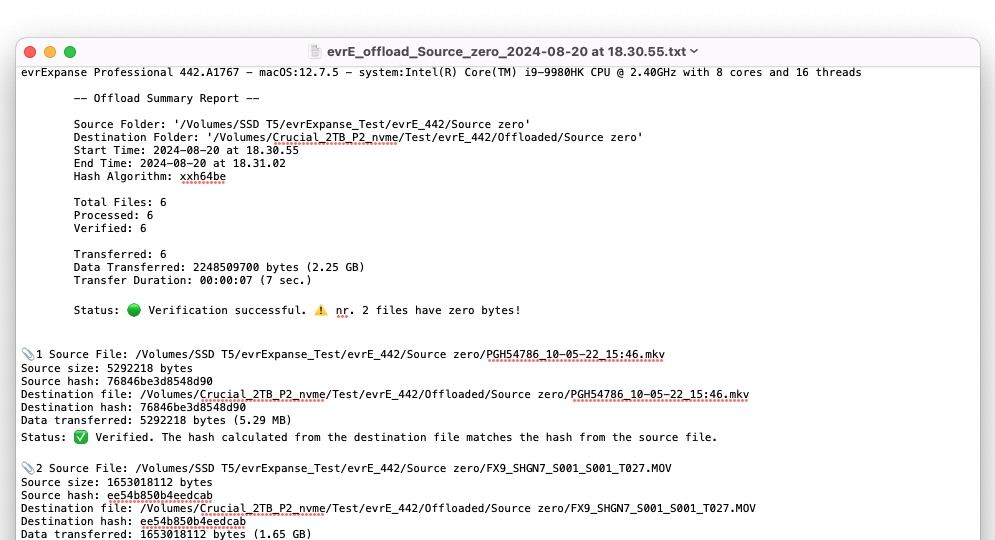
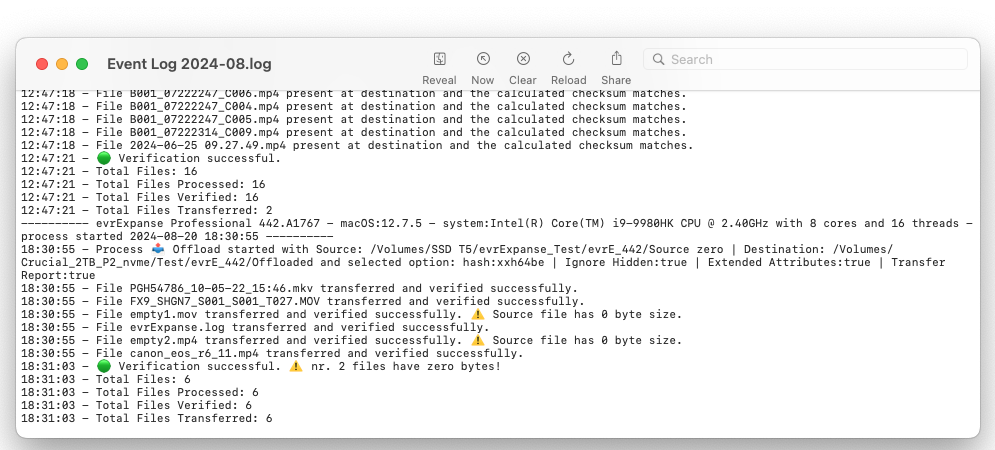
This proactive check helps maintain media integrity by ensuring that all processed files are complete and usable.
Quick Actions
evrExpanse includes five macOS Quick Actions that let you instantly assign key folder paths—Source, Destination, and up to three Offload Folders—without launching the app. These actions are added to your macOS Services (or Quick Actions) menu and can be downloaded here: Download Quick Actions.
Once installed, you'll have access to the following actions:
→ Set as 📁 Source Folder
→ Set as 📂 Destination Folder
→ Set as 📦 + Offload 1 Folder
→ Set as 📦 + Offload 2 Folder
→ Set as 📦 + Offload 3 Folder
How to Use
Right-click any folder in Finder, go to Quick Actions and choose one of the above options.
For example:
- To define a media source, right-click
ExternalDrive/Media/Day_02/and choose Set as 📁 Source Folder. - To set your working output folder, right-click
RAID/MainProject/Exports/and select Set as 📂 Destination Folder. - For backups, right-click
BackupA/Week05/Camera_A/and apply Set as 📦 + Offload 1 Folder, and repeat for + Offload 2 and 3 if needed.
Each action writes the folder path directly into evrExpanse's configuration file. When you launch the app, your selected paths are already populated and ready for Transcoding, Offloading, or Metadata Export—saving setup time and ensuring consistency across tasks.
If a Quick Action is performed while the main evrExpanse window is already open, the app won’t reflect the change immediately. To update the view and load the new paths, simply navigate to Preferences and return to the main window. This prompts evrExpanse to re-read the configuration file and apply the latest folder selections.
To Remove a Quick Action
Go to ~/Library/Services/, locate the desired .workflow file (e.g., Set as 📂 Destination Folder.workflow), and move it to the Trash. The action will disappear from Finder immediately.
Metadata Export
Selected Source Folder
To select the folder containing the media files that will be processed in evrExpanse, you can use the convenient drag-and-drop functionality from Finder. Simply locate the desired folder in your Finder window, click and hold the folder, and then drag it over to the designated area within evrExpanse. This streamlines the process of selecting media for metadata export.
Selected Export Format
Select the export format for the metadata file.
The available options are: Final Cut Pro (FCPXML or FCPXMLD), DaVinci Resolve (CSV), Media Composer (ALE), Silverstack (CSV), evrExpanse (CSV), Sony Real Time Metadata (CSV), SCRATCH Integration (.XML) and Extract LUT File from media (.CUBE).

Media Composer ALE Settings
Check the default values of Format, FPS or Bin Name. By default, the value of Bin Name is automatically filled with the name of the selected folder, but can be changed.
Assimilate SCRATCH Integration
By selecting the SCRATCH Integration option, you can send an XML file directly to the SCRATCH Watch Folder. This XML file contains references to the media files along with their associated metadata. Once the SCRATCH project is loaded, it will automatically process the XML file, incorporating the media files and metadata into the project seamlessly.
Additionally, a copy of the XML file will be saved in a folder within the processed folder. This folder will be named with the prefix evrE followed by the name of the processed folder, allowing for easy identification and organization of the XML files linked to the processed media.
Transcode Master File
Selected Source Folder
To select the Source folder containing the media files you want to transcode in evrExpanse, you have the convenient option of using drag and drop functionality from the Finder. Simply locate the desired Source folder in your Finder window, click and hold the folder, then drag it over to the designated area within evrExpanse.

Selected Destination Folder
To select the Destination folder containing the media files transcoded by evrExpanse, you have the convenient option of using drag and drop functionality from the Finder. Simply locate the desired Destination folder in your Finder window, click and hold the folder, then drag it over to the designated area within evrExpanse

Transcoding Mode
Smart
The Smart Mode in evrExpanse performs intelligent transcoding by analyzing the master file's video codec and audio format, deciding whether to transcode or pass-through based on the content.
- Video Stream: If the master video codec is an intermediate or mezzanine codec such as ProRes, DNxHR, or CineForm, Smart Mode will pass through the video stream without re-transcoding, maintaining the original quality. However, if the option "Optimize for Final Cut Pro in Smart Mode" is selected, Smart Mode will only pass through video if the codec is ProRes, ensuring compatibility with Final Cut Pro.
- Audio Stream: If the master audio codec is PCM (16-bit, 24-bit, or 32-bit), the audio stream will be passed through as well. If the codec is not PCM, evrExpanse will transcode the audio to the selected PCM bit depth.
This mode optimizes the transcoding process by avoiding unnecessary re-transcoding, preserving quality where possible.
Manual
The Manual Mode in evrExpanse is the classic transcoding option, where both audio and video streams are transcoded according to the user-selected settings. This allows for full control over the transcoding process, letting users choose the desired codecs, bitrates, and other settings for their media files.
Rewrap
The Rewrap transcoding option allows for a 100% quality pass-through of the master audio and video streams, embedding metadata in both the native format and XMP format (supported by Adobe Premiere Pro). In this mode, the output container is set to QuickTime (.MOV), except for MP4 input files, where the container remains MP4 to maintain codec compatibility.
Include Source Metadata
The “Include Source Metadata” option gives you precise control over how metadata is handled during the transcoding process.
When enabled, this option performs the following:
- ✅ Embeds all available source metadata into the transcoded file. This ensures that the resulting file retains critical camera-generated metadata (such as
CreateDate, camera model, lens info, etc.), making it possible to export from the transcoded file the same metadata as the original source. - ✅ Preserves and embeds Finder Tags and file Flags from the source file. These macOS metadata elements are written into the transcoded file's metadata stream for future reference or Smart Collection support.
- ✅ Updates the filesystem creation date of the transcoded file to match the original camera
CreateDate. This ensures that the file appears in your NLE (Final Cut Pro, DaVinci Resolve, etc.) with the correct capture time in timeline bins, browser views, and metadata panels.
When disabled, evrExpanse skips this metadata integration step. This may slightly improve transcoding speed and is useful in workflows where only the output-specific metadata is required, or where the original metadata is no longer relevant.
Transcode A/V Settings
Video Codec:
Select the ProRes / HEVC / DNxHR / CineForm / DPX / EXR profiles of your choice. Available profile are those specified in the Apple ProRes white paper and in the Avid DNxHR specification.
- Apple ProRes
Codec type: hardware accelerated (Apple VideoToolbox)
Pixel format:- YUV 4:2:2 - 10-bit (ProRes 422 Proxy, ProRes 422 LT, ProRes 422, ProRes 422 HQ)
- YUV 4:4:4:4 - 10-bit (ProRes 4444, ProRes 4444 XQ) with support for alpha channel
- Avid DNxHR
Codec type: software accelerated (CPU)
Pixel format:- YUV 4:2:2 - 8-bit (DNxHR LB, DNxHR SQ, DNxHR HQ)
- YUV 4:2:2 - 10-bit (DNxHR HQX), YUV 4:4:4 - 10-bit (DNxHR 444)
- GoPro CineForm:
Codec type: software accelerated (CPU)
Pixel format:- YUV 4:2:2 - 10-bit (low, medium, high, film1, film2, film3+ )
- RGB 4:4:4 - 12-bit (RGB 444)
- DPX:
Codec type: software accelerated (CPU)
Pixel format:- RGB 10/12/16 bit per channel
- RGBA 8 bit per channel
- EXR:
Codec type: software accelerated (CPU)
Compression: Uncompressed/Zip1/RLE
Pixel format:- RGB half/float (16/32 bit)
- RGBA half/float (16/32 bit)
- HEVC (H.265) [available in Manual mode only]
Codec type: hardware accelerated (Apple VideoToolbox)
Pixel format:- YUV 4:2:0 8-bit per channel (High, Medium, Low)
- YUV 4:2:0 10-bit per channel (High, Medium, Low)
Downscale Video Resolution
This option applies only in Manual Mode, resizing the output video only if the source exceeds the selected target, ensuring quality, compatibility, and reduced file size.
- As Source – Keeps original resolution.
- Downscale Profile – Precise control with:
- Standard: 720p / 1080p (maintains aspect ratio).
- Scaling: 50% (Half), 25% (Quarter).
- Common Heights: 1440px 🖥️ QHD, 2160px 🖥️ 4K, 4320px 🖥️ 8K.
- Vertical: 1280px 📱 HD, 1920px 📱 FHD, 3840px 📱 4K, 7680px 📱 8K.
- DCI Scope: 858px 🎥 2K, 1716px 🎥 4K, 3432px 🎥 8K.
Downscaling is applied only when the source video's resolution exceeds the selected target, ensuring high quality, better compatibility, and reduced file size where necessary.
HEVC Bitrate
evrExpanse offers two methods for applying bitrate to HEVC transcoding:
- Automatic with Profiles
- Custom Bitrate
Custom Bitrate:
This is the most straightforward method, allowing the user to manually enter a custom bitrate in the designated field located in the Transcoding Options section of the main window.
Automatic with Profiles:
This method utilizes an Adaptive Bitrate Calculation Algorithm, which dynamically adjusts the bitrate based on the video resolution and frame rate of each source video in the batch. It compares the input against a reference bitrate of 24,000 Kbps for a 4K UHD (3840x2160) video at 30fps for the High profile. The Medium profile uses 50% of the High bitrate, and the Low profile uses 25%.
While the following table provides standard examples, evrExpanse can handle a wide range of image sizes, frame rates, and aspect ratios, making it adaptable to diverse transcoding needs:
| Resolution | Frame Rate | High (Kbps) | Medium (Kbps) | Low (Kbps) |
|---|---|---|---|---|
| 720p | 24 | 3695 | 1848 | 1232 |
| 30 | 4619 | 2309 | 1540 | |
| 60 | 9238 | 4619 | 3079 | |
| 120 | 18475 | 9238 | 6158 | |
| 1080p | 24 | 6788 | 3394 | 2263 |
| 30 | 8485 | 4243 | 2828 | |
| 60 | 16971 | 8485 | 5657 | |
| 120 | 33941 | 16971 | 11314 | |
| 2160p | 24 | 19200 | 9600 | 6400 |
| 30 | 24000 | 12000 | 8000 | |
| 60 | 48000 | 24000 | 16000 | |
| 120 | 96000 | 48000 | 32000 | |
| 8K | 24 | 54306 | 27153 | 18102 |
| 30 | 67882 | 33941 | 22627 | |
| 60 | 135765 | 67882 | 45255 | |
| 120 | 271529 | 135765 | 90510 |
10-bit HEVC Transcoding Support:
evrExpanse supports HEVC transcoding up to 10-bit depth with customizable bit depth management.
If the source video is 10-bit, the Auto option ensures it’s transcoded to HEVC 10-bit, preserving color depth. For 8-bit sources, it’s transcoded to HEVC 8-bit, avoiding unnecessary conversion. These options provide flexibility, ensuring compatibility and efficiency while maintaining optimal video quality.
Audio Codec
evrExpanse supports PCM audio formats in 16-bit, 24-bit, and 32-bit. When transcoding, users can choose to:
- Re-encode audio in one of the available PCM formats, or
- Use Passthrough mode to copy the original audio stream without re-encoding, preserving its original format and quality.
Audio is transcoded in a 1:1 configuration with the source file, maintaining the exact number of tracks and channels as in the original master. When transcoding to image sequence formats like DPX or EXR, any audio tracks present in the master file will be exported separately as a WAV file, since audio cannot be embedded within these formats.
Burn-in Metadata Overlay
The Burn-in Metadata option overlays key metadata directly onto the video during transcoding, embedding it permanently into the output file. Common uses include displaying timecodes, camera settings, or applied 3D LUTs for quick reference during review or post-production.
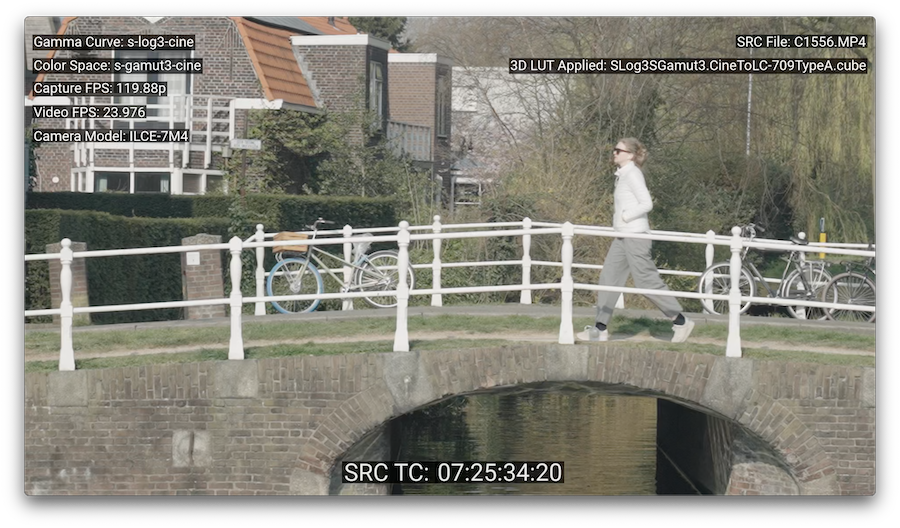
This feature is especially valuable for collaboration, quality control, and workflows where visual access to metadata is essential.
3D LUT Application and Smart LUT Finder Features
evrExpanse 5 introduces powerful tools for color grading with its 3D LUT Application and Smart LUT Finder features.
Apply 3D LUT allows you to burn a 3D LUT directly into the transcoded file, ensuring consistent color across all outputs. The available options include:
- Use Sidecar LUT: Automatically applies a LUT from the same folder as the media, matching the LUT file to the media based on filenames.
- Custom LUT Folder: Offers flexibility by letting you select a folder of LUT files, which are then automatically matched to the corresponding media files.
- Apply LUT File: Enables the use of a single, user-defined LUT across all media files in a batch, ensuring uniform color grading throughout the project.
Smart LUT Finder Features
The new Smart LUT Finder streamlines color grading by automatically detecting and applying the correct LUT based on video file metadata. Whether using options Use Sidecar LUT or Custom LUT Folder, evrExpanse automatically searches for and applies LUT files associated with your media.
How It Works:
Sidecar File Detection:
evrExpanse searches for a sidecar .cube file where the media file name appears at the beginning of the corresponding .cube filename. The expected format is:
[media file name][optional additional text].cube
For example, if the media file is named video123.mp4, evrExpanse will detect a matching sidecar LUT file with names such as:
video123.cube
video123_lut.cube
video123_custom.cube
Metadata-Based Extraction:
For supported cameras (Kinefinity, McPro24fps, and ARRI), if no sidecar file is found, Smart LUT Finder reads the metadata to locate and extract the correct LUT.
Important Condition:
Metadata-Based Extraction is engaged only when the "Include Source Metadata" setting is checked during transcoding. This ensures that the necessary metadata is extracted and applied for seamless LUT handling.
Destination File Name
In this field, you can personalize the name of the transcoded files by adding custom text to the end of the original file name. For example, if the source file name is "A005C039_201101OZ.mov" and you choose to add the text "CamA", the resulting file name will follow one of these formats:
If the "Preserve Source File Name" option is disabled:
[SourceFileName]_evrE_[CodecName_CodecProfile]_YourText.mov
For example:
A005C039-201101OZ_evrE_DNxHR_CamA.mov
If the "Preserve Source File Name" option is enabled:
[SourceFileName]_YourText.mov
For example:
A005C039-201101OZ_CamA.mov
This feature allows you to easily differentiate and identify the transcoded files by adding custom text, providing additional context or information related to your workflow. It gives you flexibility in organizing your files based on your specific requirements or preferences.
Duplicate Source File Name
When source files are located in different folders, it's possible for multiple files to share the same name. While this may not cause issues in some workflows, it can lead to conflicts in others.
If the "Preserve Source Folder Structure" option is enabled, evrExpanse maintains the original folder hierarchy, preventing naming conflicts by placing each file in its corresponding subfolder.
However, when this option is disabled, all transcoded files are saved into a single output folder. In this case, files with the same name may overwrite one another.
To avoid this, evrExpanse automatically renames duplicate files using the following convention:
[SourceFileName]_(checksum_DupRefx)_YourText.mov
This ensures that all transcoded files remain unique, even when source names are identical.
Breakdown of the Naming Convention:
- SourceFileName: The original name of the source file.
- checksum: A unique xxh64 hash of the original source file, used to identify whether files with the same name are truly identical or just share the same name.
- X: A reference number (DupRef) that serves as a unique identifier for each transcoding process.
- YourText: An optional custom text that users can append to the file name.
Example:
For a source file named A005C039-201101OZ.mov, the renamed file in the destination folder might look like:
A005C039-201101OZ_(38efdc3d5595ff1d_DupRef3)_CamA.mov
This naming convention ensures that files with the same name but different content are easily distinguished. It also highlights whether files are identical based on their checksums.
Example Scenarios:
Identical Files:
Clip0001_(38efdc3d5595ff1d_DupRef3)_CamA.movClip0001_(38efdc3d5595ff1d_DupRef7)_CamA.mov
Different Files with the Same Name:
Clip0001_(38efdc3d5595ff1d_DupRef3)_CamA.movClip0001_(3799dc67f0aaeafc_DupRef5)_CamA.mov
This system provides a robust method for handling duplicate file names without risking data loss or overwriting, ensuring each file remains distinct in the destination folder.
Offload
Source Folder
To select the Source Folder containing the media files you want to offload, evrExpanse supports convenient drag-and-drop functionality from Finder. Simply locate the folder in Finder, click and hold it, then drag it into the designated area within evrExpanse.
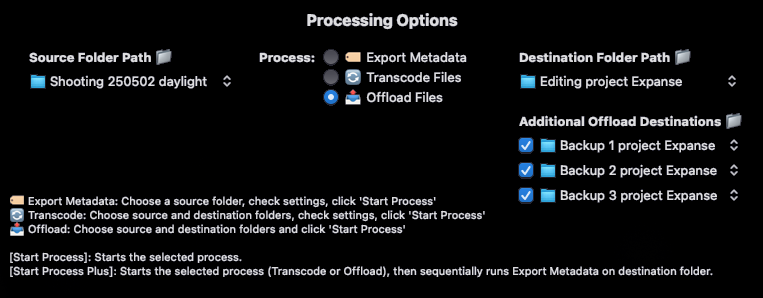
Destination Folder
evrExpanse offers flexibility when choosing where your files will be transferred. You can set:
- One primary Destination Folder
- Up to three Additional Offload Destinations
This allows you to offload media simultaneously to a working drive and multiple backups.
Use drag and drop from Finder to assign each folder to the appropriate field under Processing Options. Enable or disable each destination using the checkboxes next to each path.
When you click "Start Process", evrExpanse will:
- Verify the source folder
- Apply your selected preferences (e.g., skip hidden files, preserve Finder tags)
- Transfer the files to all enabled destinations
- Perform verification at each step to ensure transfer integrity
Offload Summary Reports
Depending on how many destinations are configured, the summary feedback varies:

Single Destination: Once offload completes, you’ll see a compact summary window showing total files, verification results, and transfer count for the primary destination. Options include: Open Destination Folder, Transfer Report, Event Log.
Multiple Destination: After all folders are processed, evrExpanse presents a clear summary overview. This includes a per-folder breakdown showing Total Files, Processed, Transferred, Verified, and a final verification status indicated by a green or red semaphore-style icon. This allows users to quickly assess the success of the offload to each destination and identify any discrepancies at a glance.
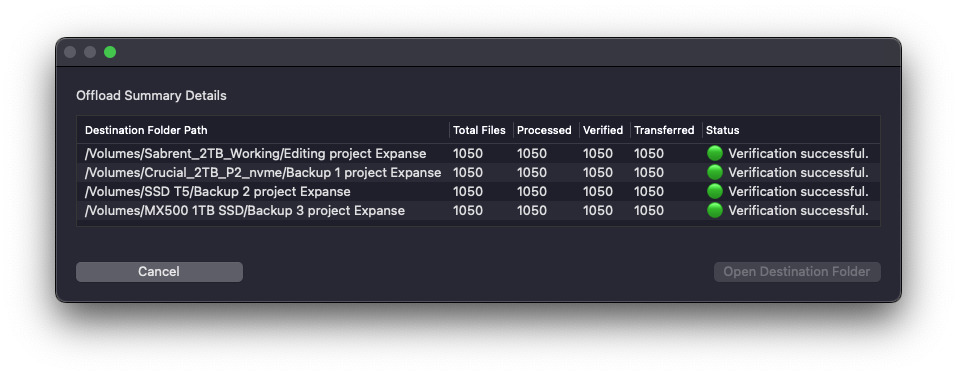
Tip: In multi-destination setups, this summary helps confirm that each target location received the full file set, and flags any inconsistencies for quick follow-up.
Detailed Transfer Report
If the "Save the Transfer Report to the destination" option is enabled, a detailed report is generated alongside the offloaded files, providing a comprehensive record of the transfer process. Users receive a confirmation notification upon completion. The offload process is finalized, ensuring a controlled and documented transfer of files with enhanced data integrity and transparency.
File Integrity Check & Duplication Handling
In cases where a file already exists at the destination, evrExpanse performs a comprehensive checksum comparison, regardless of file size or modification date. This meticulous verification ensures that the source and destination files are 100% identical, providing bulletproof file integrity.
If the checksum of the destination file does not match the source file, evrExpanse duplicates the source file at the destination, appending 2 (evrE copy) to the end of the file name. It then recalculates and compares the checksums again to verify accuracy. This process guarantees incremental transfer with secure and reliable duplication handling.
Results
During each process, a progress bar will be displayed to track the progress.
If you need to stop the batch process, click the Stop button. When prompted with a warning message, click the End button and wait for the current file to finish processing. It is strongly recommended to let the process shut down properly, which usually takes just a few seconds.
Once a process completes, a completion window will appear, offering options to access the processed files, review the event log, or view a report.
Metadata Export Process
When the Metadata Export process is completed, a folder named evrE_FolderName will be created inside the destination folder. This folder contains the exported metadata in the selected formats, ready for use with corresponding NLEs (Non-Linear Editing systems).
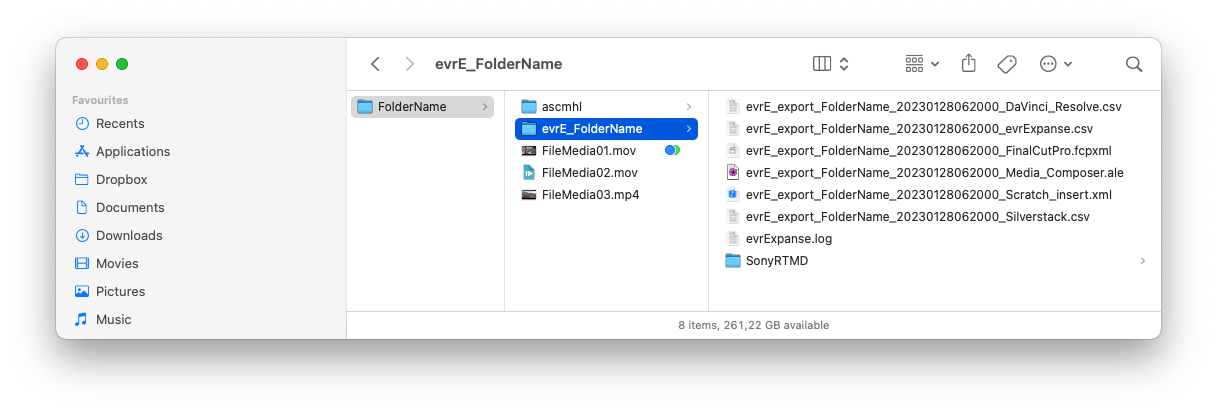
Transcode Process
After the Transcode process is finished, the destination folder will contain the transcoded files. If you selected the option to preserve folder structure, a folder will be created with the name of the source folder, and the transcoded files will be stored inside.
Additionally, a folder named evrE_FolderName will be created in the destination folder, containing the event log for the process. This log provides detailed information about the transcoding process and settings used.
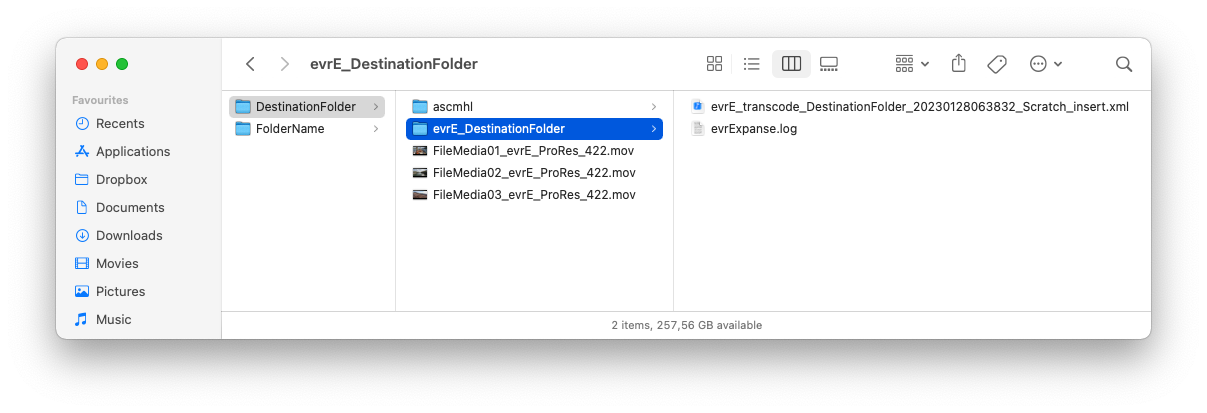
Offload Process
For the Offload process, a folder named FolderName_offload_report will be created alongside the offloaded folder in the destination directory. This folder will include an offload report detailing the transferred files.
Additionally, for all processes, if required, you'll find a folder named ascmhl containing ASC MHL files or a single MHL file inside the offloaded folder for media integrity verification.
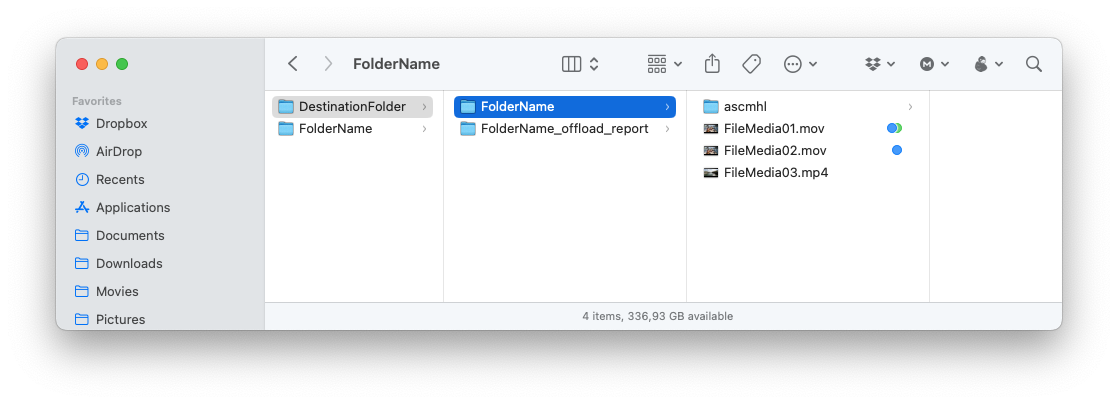
Event Log
Additionally, a log file named evrExpanse.log will be saved. While the Event Log aggregates events from all processes initiated by the host machine, the log file located in the processed folder contains events specific to that particular folder. This ensures that you have both an overview of all activities and detailed logs for each individual folder and process.
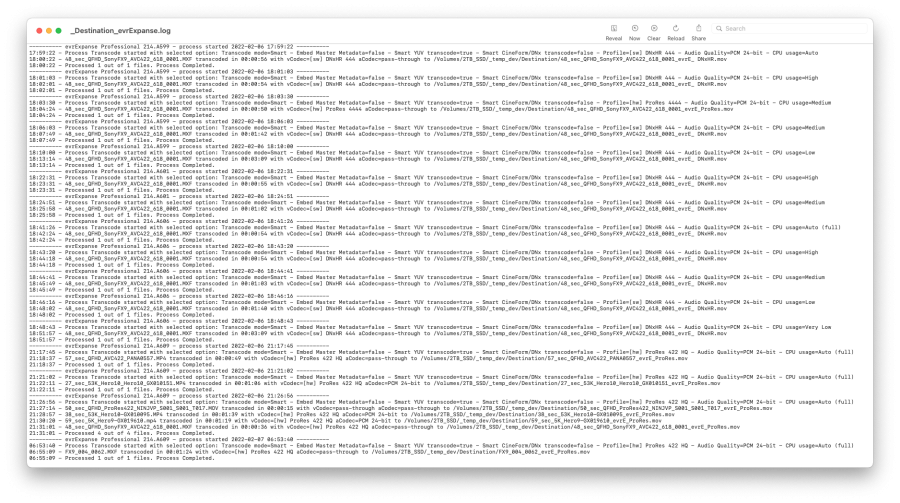
Preferences
Prior to executing any process within the application, it is highly recommended to take a moment to review the Preferences and either modify or confirm the default settings.
General Preferences
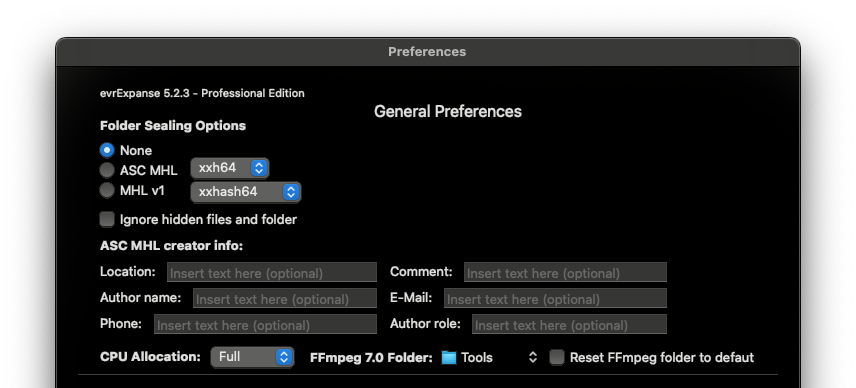
Seal processed folder (MHLs)
Sealing a folder with an MHL (Media Hash List) involves generating cryptographic hashes for each file, which are stored in a hash list. This serves as a digital fingerprint of the folder’s contents at a specific point in time, enabling later verification of file integrity and detection of any changes or tampering.
evrExpanse supports two MHL formats:
- ASC MHL – A modern standard developed by the American Society of Cinematographers (ASC) to ensure consistency and efficiency in media workflows.
- MHL v1 – The original format developed by Pomfort.
When the sealing option is enabled, evrExpanse will apply it to the selected process: Metadata Export, Transcode, or Offload.
Select MHL type and Hash Format
Within the same window, you can enable or disable the creation of ASC MHL or MHL v1 files. When enabled, evrExpanse generates a separate hash list for each processed media file, which can be saved alongside the file or in a specified folder. Disabling this option skips hash list creation, giving you flexibility based on your workflow.
Available hash formats:
- ASC MHL: xxhash (64-bit), xxh3 (64-bit and 128-bit), md5, sha1, sha256, c4
- MHL v1: md5, sha1, xxhash, xxhash64be, xxhash64
Ignore Hidden Files and Folders
evrExpanse provides an option to exclude hidden files and folders when sealing a processed folder. By default:
- ASC MHL ignores macOS system files like
.DS_Storeand theascmhlfolder. - MHL v1 includes all files, but evrExpanse filters out
.DS_Storefor consistency.
The evrExpanse.log file is always included in both MHL types. You can choose to exclude any other hidden files or folders as needed
Comparing the behavior differences between ASC MHL and MHL v1 files or folders:
| ASC MHL | MHL v1 |
|---|---|
| Ignores system file .DS_Store and the 'ascmhl' folder | Ignores system file .DS_Store |
| Filters the 'evrExpanse.log' file | Filters the 'evrExpanse.log' file |
| Optionally ignores other hidden files or folders | Optionally ignores other hidden files or folders |
Each time evrExpanse creates an MHL file or seals a folder, it checks for the presence of older MHL files and verifies whether the referenced files exist in the current folder.
Any exceptions encountered will be recorded in the log file named evrExpanse.log as well as in the Event Log session.


In order to commence the Metadata Export process within evrExpanse, it is imperative to ensure the fulfillment of a basic condition: activating either an export format, SCRATCH integration, or sealing the processed folder using your preferred MHL type.
ASC MHL Creator Info
In the ASC Media Hash List (MHL) settings within evrExpanse, you can specify the Creator Info and select the preferred hash encoding format. The Creator Info field allows you to include details about the author or origin of the media files, providing clearer documentation and traceability.
By defining this information and choosing a suitable hash algorithm, you tailor the ASC MHL file to meet your workflow needs—ensuring accurate identification of media assets and reliable data integrity verification throughout post-production.
CPU Allocation
The CPU Allocation option in evrExpanse intelligently manages CPU resources across Transcoding, Export Metadata, and Offloading processes. It balances the load on CPU threads to optimize performance based on your system’s capabilities.
CPU Load Profiles:
- Full: Maximizes CPU usage across all threads, optimising tasks like transcoding and metadata export.
- High: Uses 75% of CPU resources, balancing performance and system stability.
- Medium: Uses 50% of CPU resources, reducing heat and preventing throttling.
- Low: Limits CPU usage to 25%, keeping the system responsive, ideal for lower-end systems or multitasking.
When using hardware-accelerated codecs, CPU allocation is less impactful, but still important for non-accelerated tasks. For most users, High or Medium is recommended to prevent overheating and maintain stability during long tasks. Adjusting CPU profiles lets you fine-tune evrExpanse's performance to match your hardware for a smooth workflow.
Custom FFmpeg Binary Folder
In the Preferences panel, you can customize the FFmpeg binary used by evrExpanse by setting a folder containing the desired FFmpeg binary. Simply drag and drop the folder from Finder into the designated field within the Preferences panel. If needed, you can revert to the default FFmpeg folder by enabling the Reset to Default checkbox, which will automatically restore the application’s original FFmpeg binaries.
Export Metadata Preferences
SCRATCH Integration
In the Metadata Export Preferences section of evrExpanse, you can configure settings for seamless integration with SCRATCH. This includes specifying the SCRATCH Watch Folder, which is pre-filled with a default location where evrExpanse will send media files and their associated metadata for automatic import into SCRATCH.
You can also define the SCRATCH project name, group, and timeline. It is essential to enter a valid and existing project name—matching exactly with what’s set in SCRATCH—to ensure the transfer completes successfully. Incorrect project names can result in a failed or incomplete upload.
Final Cut Pro XML
In the main window, clicking on the "Preferences..." button takes you to the "Metadata Export Settings" section where you can choose the desired Final Cut Pro FCPXML format (FCPXML v1.9, FCPXMLD v1.10, FCPXMLD v1.11, FCPXMLD v1.12 and FCPXMLD v1.13).



Process Transcode Preferences
YUV Format Preservation in Smart Mode
The "Preserve YUV Format" option provides greater control during transcoding in Smart Mode. When enabled, evrExpanse analyzes the input file and, if it is already in YUV format, it will bypass transcoding and directly copy the video stream to the output.
This saves time and system resources by avoiding unnecessary processing of files that are already optimized for delivery. It also helps preserve the original video quality and characteristics.
Maintain Final Cut Pro Compatibility in Smart Mode
When Smart Mode is enabled and the "Optimize for Final Cut Pro" option is selected, evrExpanse automatically transcodes media files using CineForm or DNx codecs to Apple ProRes. This ensures compatibility with Final Cut Pro, which does not support these codecs.
With this option enabled, only ProRes profiles will be used during transcoding, guaranteeing that your media is fully compatible for seamless import and editing in Final Cut Pro. This eliminates codec-related issues and simplifies workflow integration.
Rotate Transcoded Files According to Source Metadata.
When enabled, evrExpanse automatically applies rotation to transcoded files based on the source file's metadata, ensuring the correct orientation is preserved in the output.
This Auto-Rotation feature is only available during transcoding in Manual or Smart Mode. It does not apply when using Rewrap Mode or when no transcoding takes place. Because the rotation relies on metadata extraction during the transcoding process, it is skipped if transcoding is not performed.


Preserve Source File Name in Transcoded File
The "Keep Original File Name" option in evrExpanse ensures that transcoded files retain the same name as the source file, making it easier to track and organize media assets.
When enabled, the original file name is preserved. For example, a source file named example_video.mp4 will be transcoded to example_video.mov, maintaining consistency for easier identification.
When disabled, evrExpanse applies its default naming convention:
[SourceFileName]_evrE_[CodecName_CodecProfile].mov
This option is ideal for workflows that require file name consistency. For advanced customization, additional naming options are available in the evrExpanse settings.
Maintain Folder Structure
The "Maintain Folder Structure" option, found in the Preferences panel, ensures that your transcoded files mirror the original folder organization of your source media. This is especially useful for workflows that rely on structured directories for project management and archival.
HEVC Bit Depth
evrExpanse 5 allows you to customize the bit depth when transcoding to HEVC. You can choose from the following options:
- Auto: Automatically matches the bit depth of the original file.
- 8-bit: Applies an 8-bit depth to all files in the batch.
- 10-bit: Applies a 10-bit depth to all files in the batch.
This flexibility ensures you can tailor the transcoding process to meet the specific needs of your project.
Process Offload Preferences
Ignore hidden files and folders
The "Ignore Hidden Files and Folders" option ensures that hidden items within the source directory—such as system files or configuration data—are excluded from the offload process. These files are typically not intended for user interaction and can clutter the destination if transferred unnecessarily.
By enabling this option, evrExpanse focuses solely on visible, user-relevant media, streamlining the offload and avoiding the transfer of unwanted or system-related data.

Include extended attributes
The "Include Extended Attributes" option ensures that Finder tags—such as color-coded labels used for organizing files—are preserved during the offload process in macOS. These tags help users categorize and visually identify files and folders.
Save the transfer report to the destination
When enabled, this feature saves a comprehensive transfer report directly to the destination folder, alongside the offloaded files. The report includes detailed information such as file names, timestamps, verification results, and any issues or errors encountered during the offload process. This provides full transparency and allows you to easily review and confirm the success and integrity of the transfer.
The Preferences Buttons
In the preferences panel there are three buttons (from left to right): Deactivate Licence, Event Log, Default Settings, User Manual and Return to Main Window

Deactivate Licence
Event Log
Clicking the "Browse All Past Months Logs" button provides access to the application's comprehensive log file, which captures events from every process executed since the first run on the host machine. The Event Log is saved monthly using the naming convention Event Log YYYY-MM.log.
When you click the "View Current Month Log" button, a window will open, allowing you to view the current month's event log or browse logs from previous months.
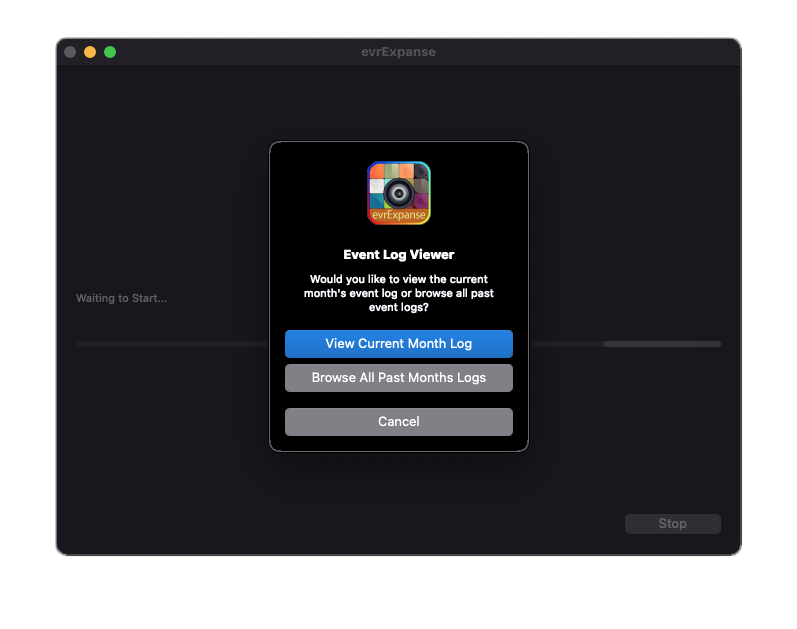
The event log tracks all events for each process and is saved on a monthly basis. Additionally, a local log file is generated within the processed folder's report subfolder, providing detailed logs specific to each process.


Reset to Default Settings
The Reset Settings button is located in the Preferences panel of evrExpanse. Clicking this button will reset all application settings to their default values. This can be useful if you encounter issues with the software or simply want to revert to the original configuration. Note that using this feature will erase any custom settings you have configured, so it is recommended to use it with caution. To ensure the reset settings take full effect, it is necessary to reboot your Mac after performing the reset.
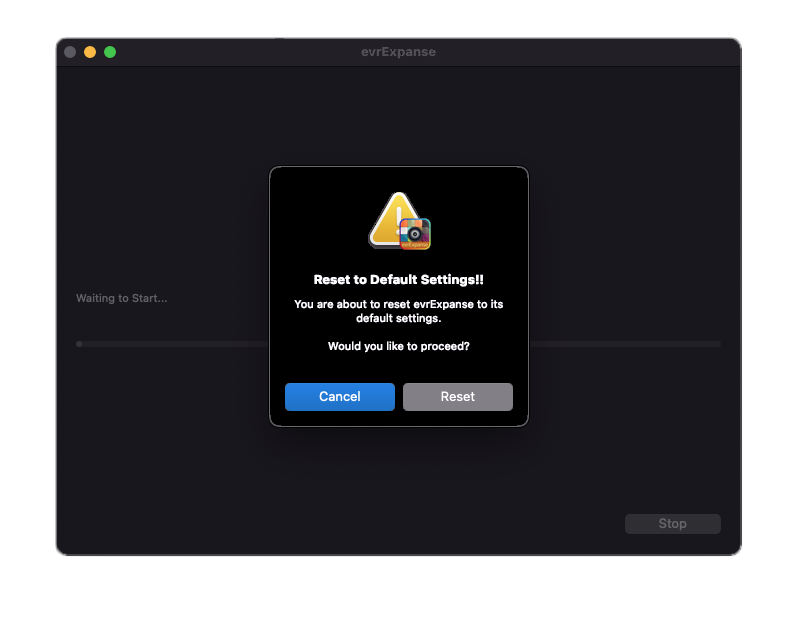
User Manual
In order to ensure a smooth user experience, we recognise the significance of comprehensive documentation. To facilitate easy access to information and guidance, we have introduced a User Manual Button in the Preference panel.
Return to Main Window
When clicked, it seamlessly guides the user back to the main interface or primary window of evrExpanse, ensuring easy access to essential features and functions.
Media Files and Camera Specifications
evrExpanse supports a wide range of media file types including MOV, MP4, MKV, NEV and MXF formats. Additionally, it is compatible with various camera models from popular manufacturers such as Panasonic, Nikon, Sony Alpha, Fujifilm, Canon, Sony XDCAM*, Z Cam, Kinefinity**, Atomos (Ninja & Inferno), McPRO24fps, GoPro, FiLMIC PRO, Apple iPhone, and ARRI.
While the Export Metadata feature is specifically tailored to the cameras mentioned above, the Transcoding functionality is available for all supported file types, including MOV, MP4, MKV and MXF.
For an up-to-date and comprehensive list of cameras supported by evrExpanse, please refer to our Camera Compatibility Tables.
How to import CSV file in DaVinci Resolve
To import a CSV file containing metadata into DaVinci Resolve, follow these steps:
Open a project in DaVinci Resolve, which should already have clips that you want to populate with imported metadata. Make sure the Media Pool is selected (indicated by a red line).
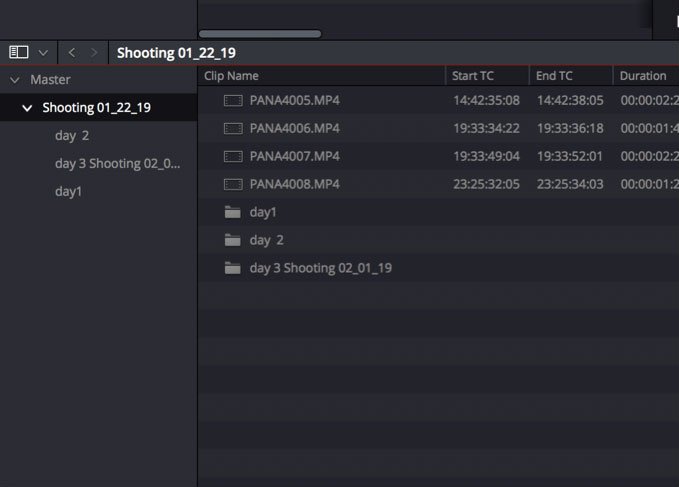
Choose File > Import Metadata To > Media Pool... to import metadata to potentially every clip in the Media Pool, or choose File > Import Metadata To > Selected Clips... to only import metadata to clips you selected.
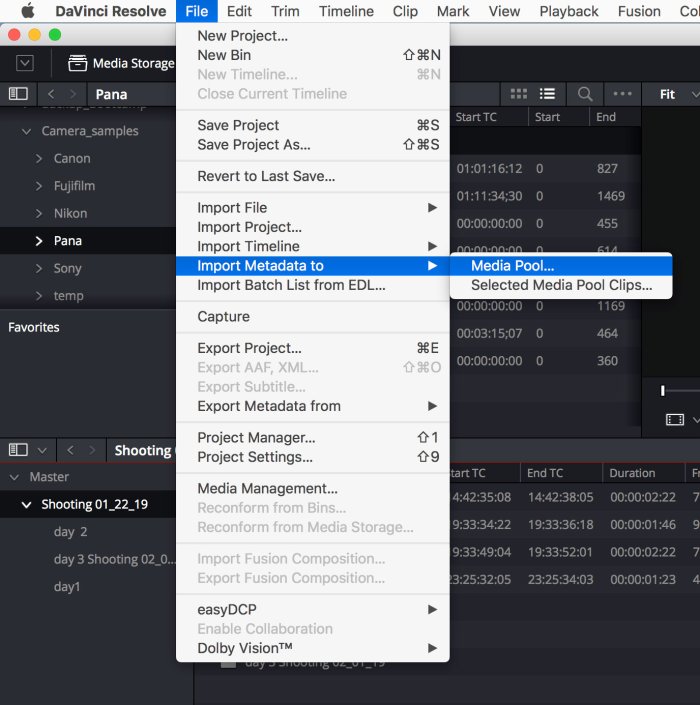
When the Import Metadata dialog appears, choose the metadata CSV file generated by evrExpanse, and click Open.
When the Metadata Import dialog appears, by default, DaVinci Resolve tries to use “Match using filename” and “Match using clip start and end Timecode” to match each line of metadata in the CSV file with a clip in the Media Pool, but because "clip start and end Timecode" are not present in imported metadata you have to uncheck “Match using clip start and end Timecode” and (optionally) check “Match using source file paths".
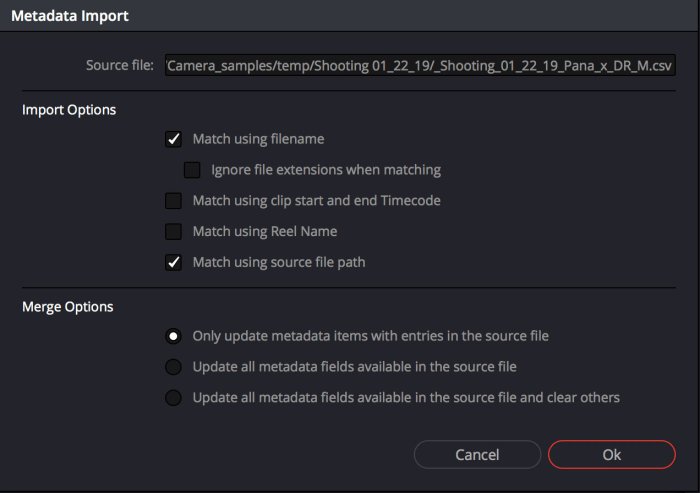
Next, choose which Merge Option you want to use in the Metadata Import dialog.
There are three options:
- Only update metadata items with entries in the source file (recommended).
The default setting. Only updates a clip’s metadata if there’s a valid entry in the imported CSV file. Other clip metadata fields are left as they were before the import. - Update all metadata fields available in the source file: For each clip that corresponds to a line of metadata in the imported CSV file, every single metadata field referenced by the CSV file is overwritten, regardless of whether or not there’s a valid entry for that field.
- Update all metadata fields available in the source file and clear others: For each clip that corresponds to a line of metadata in the imported CSV file, every single metadata field referenced by the CSV file is overwritten, regardless of whether or not there’s a valid entry for that field.
Furthermore, metadata fields that aren’t referenced by the imported CSV file are cleared of
When you’re finished choosing options, click OK and all available metadata from the source CSV file will be imported.
When media files are tagged using the macOS Finder Tag, the associated information will be displayed in the Keyword window and the Flags section within DaVinci Resolve.
This integration allows for seamless transfer of tags from the macOS Finder to DaVinci Resolve, providing easy access to the tagged information. In the Keyword window, you can view and manage the tags applied to the media files, enabling efficient organization and categorization of your assets. Additionally, in the Flags section, you can quickly identify flagged files based on the tags assigned to them.
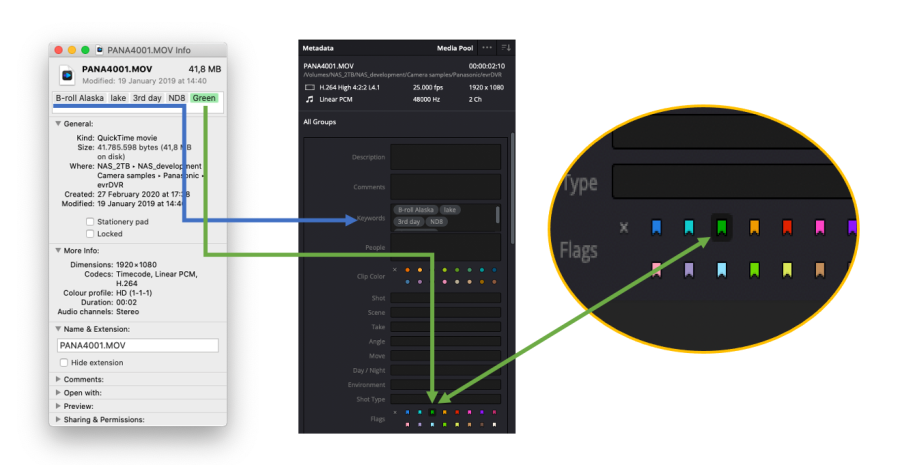
How to import in Final Cut Pro
Importing media and its metadata into Final Cut Pro with FCPXML is pretty easy and straight forward. Just double-click on the exported file (.FCPXML or .FCPXMLD) and Final Cut Pro will automatically start and ask which library to import the files into.
Alternatively you can import the FCPXML file from the application itself.
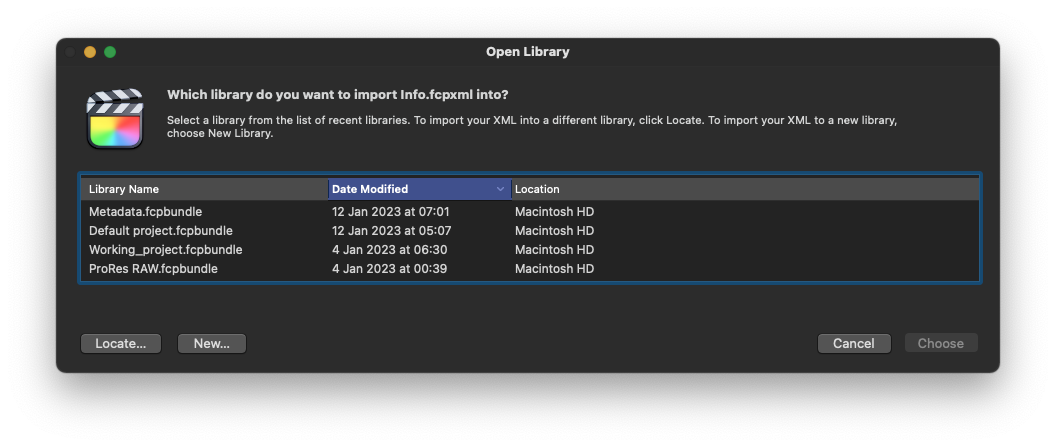
When you select media from the browser, you will see the metadata in the information inspector. All metadata will be bundled into a new Metadata View called evrExpanse.
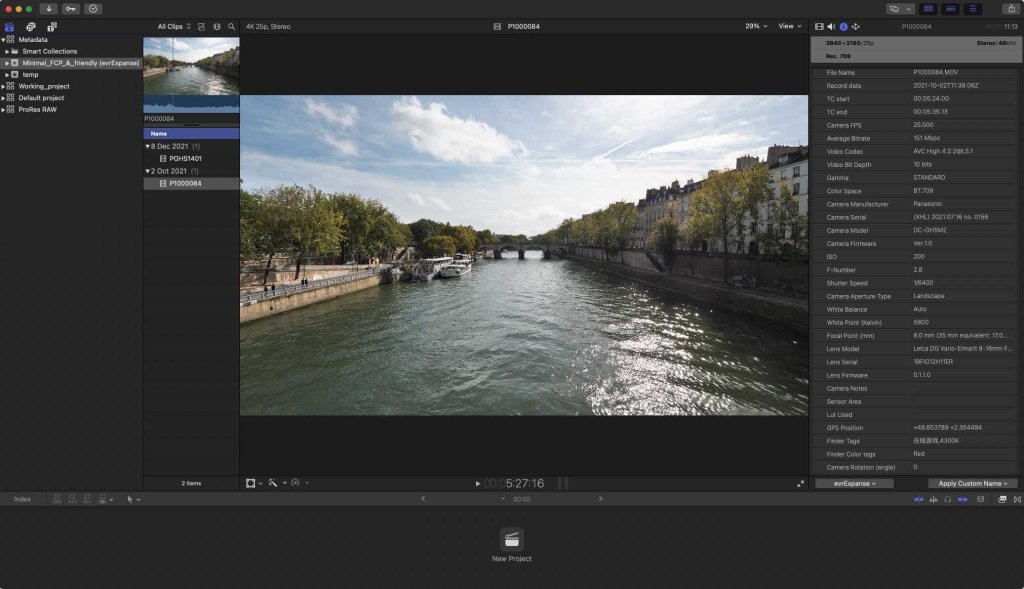
All media files already present in an FCP event and/or in a timeline, inherit the imported metadata of the corresponding processed files.
If you open the Metadata Views window by selecting "evrApp Properties" you will be able to add the imported metadata to your liking in any existing metadata view.
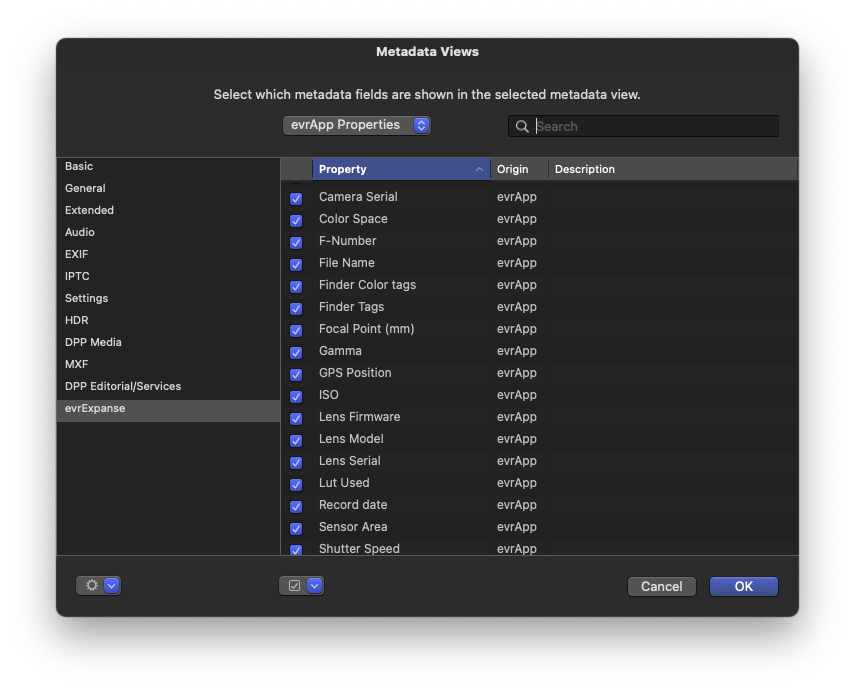
Creating a Smart Collection in Final Cut Pro Using evrExpanse Metadata
1. Export FCPXML from evrExpanse 5
Ensure your media files are exported with the relevant metadata embedded in the FCPXML format from evrExpanse 5.
2. Import the FCPXML into Final Cut Pro
Using the Menu:
- Open Final Cut Pro.
- Go to File > Import > XML and select the FCPXML file you exported from evrExpanse.
Using Finder:
- Locate the FCPXML file in Finder and double-click it. This will automatically open it in Final Cut Pro.
3. Check the Metadata
After importing, select a clip to view its metadata in the Inspector. Confirm that the relevant metadata fields are correctly populated.
4. Create a New Smart Collection
- Right-click on the library name in the Libraries sidebar or click New Smart Collection at the bottom.
5. Set Smart Collection Criteria
- Use the dropdown menus to set the initial criteria.
- Select Text > All Text and input the specific text you want to filter by (e.g., a string from the metadata).
6. Add Additional Criteria (Optional)
- To refine your Smart Collection, click the "+" button next to your existing criteria.
- Select Text > All Text again and input any additional text or criteria you want to filter by.
7. Close the Window to Create the Smart Collection
Close the window to save and create the Smart Collection. It will automatically update to include clips that match all the specified criteria.
Troubleshooting
Activating evrExpanse 5 Metadata View in Final Cut Pro
If you upgraded from version 3 or 4 to evrExpanse 5, your existing metadata view should automatically migrate to the new format. However, if you check the inspector to view the new metadata list before the first importing with the latest version of evrExpanse, you may notice that after importing the XML file, the metadata doesn't appear for the processed files.
This can also occur when importing metadata for the first time in evrExpanse 5.
Don’t worry—your metadata is still intact. The newly enhanced evrExpanse Metadata View just needs to be activated or refreshed. This only needs to happen once, and once activated, it will inherit the previously imported metadata, automatically converting it to work with Smart Collections and making it searchable in the browser.
1. Open evrExpanse:
- Launch evrExpanse 5 and select the source folder containing your media files.
- Export the metadata by selecting the Final Cut Pro format in evrExpanse.
2. Import Metadata into Final Cut Pro:
- Once the export is complete, open Final Cut Pro.
- Double-click the
.FCPXMLor.FCPXMLDfile generated by evrExpanse to import both the media and metadata into FCP.
3. Access the Metadata View:
- After the media is imported, select a clip in the FCP timeline or browser.
- In the Info Inspector, open the Metadata View dropdown.
4. Activate Metadata View:
- From the Metadata View dropdown, select Edit Metadata View....
- On the left side of the Metadata View window, you'll see a list of available metadata views, including evrExpanse.
- Select evrExpanse and click OK to confirm and activate the view.
Points 1 and 2 are necessary steps to "wake up" the enhanced evrExpanse Metadata View. Without completing these steps in sequence, the new metadata will not be visible in FCP. Once these steps are performed, the enhanced view will be available for all future projects.
This procedure only needs to be performed once to enable the enhanced evrExpanse 5 Metadata View in Final Cut Pro.
Refreshing Metadata Labels in Final Cut Pro
If you've updated to a new version of evrExpanse and your custom metadata fields don’t show the latest names (labels), follow these steps to refresh them in Final Cut Pro:
- Open Final Cut Pro.
- In the Info Inspector, open the Metadata View menu and choose Edit Metadata Views…
- Select any old evrExpanse fields (e.g., Record date) and delete them
(Right-click > Delete Custom Metadata Field). - Close and reopen Final Cut Pro.
- Import the updated FCPXML exported by evrExpanse.
The updated metadata labels will now appear correctly in the Info Inspector.
How to import in Assimilate Scratch
The import of multimedia files and related metadata in Assimilate SCRATCH is even simpler and more direct than in Final Cut Pro. In this case the integration is direct: once the export process is finished, the XML file, generated by evrExpanse, is stored in the SCRATCH Watch folder which will load it as soon as the application is started and the relative project is opened.
Make sure the project name to SCRATCH is set correctly in the evrExpanse settings and you're done! SCRATCH history populated with processed media and corresponding metadata displayed in the right panel.
A copy of the XML file is also saved in the processed files folder (evrE_FolderName) in case the XML file needs to be uploaded to another workstation.
After SCRATCH processes the XML file in the watch folder, it will write a log to the Scratch_insertlogFolderName.log file located inside the processed folder evrE_FolderName
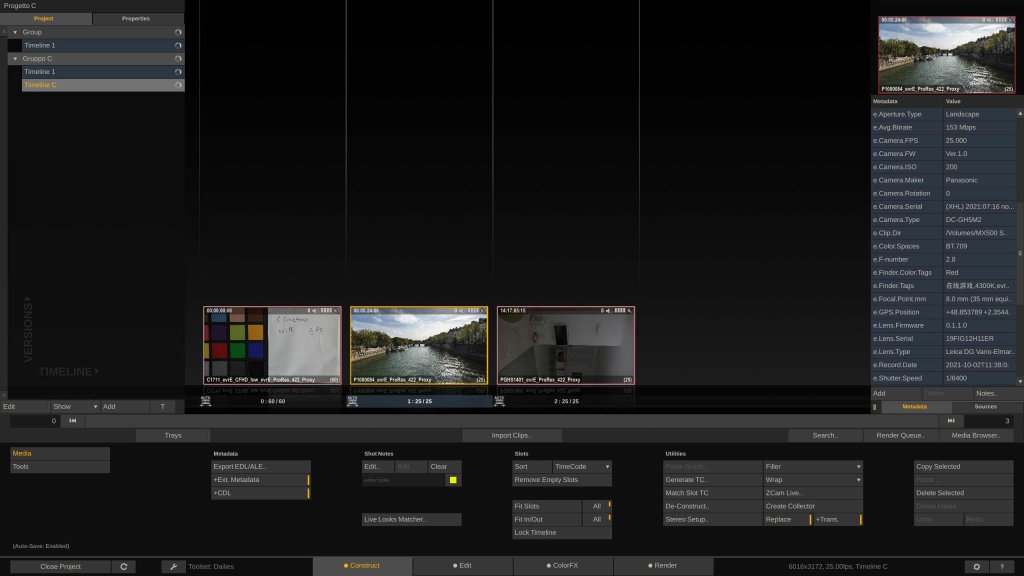
How to import ALE file in Avid Media Composer
After having created the .ale file in evrExpanse, go to the Avid Media Composer and import the clips if not done so far. They should thereon be available as master clips.
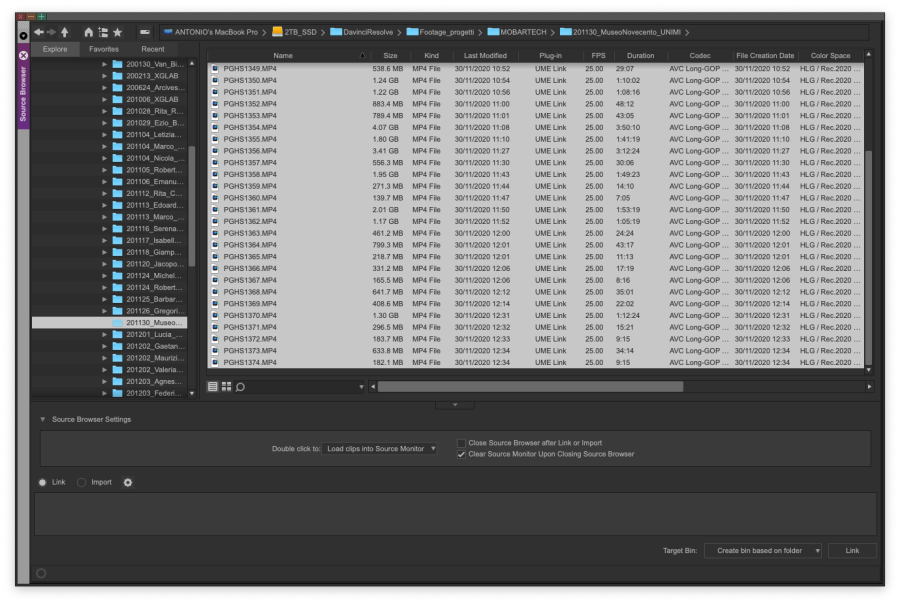
Select the bin in the Avid Media Composer which contains the relevant clips.
Select those clips and choose “Input > Import Media…” from the context menu in the bin.
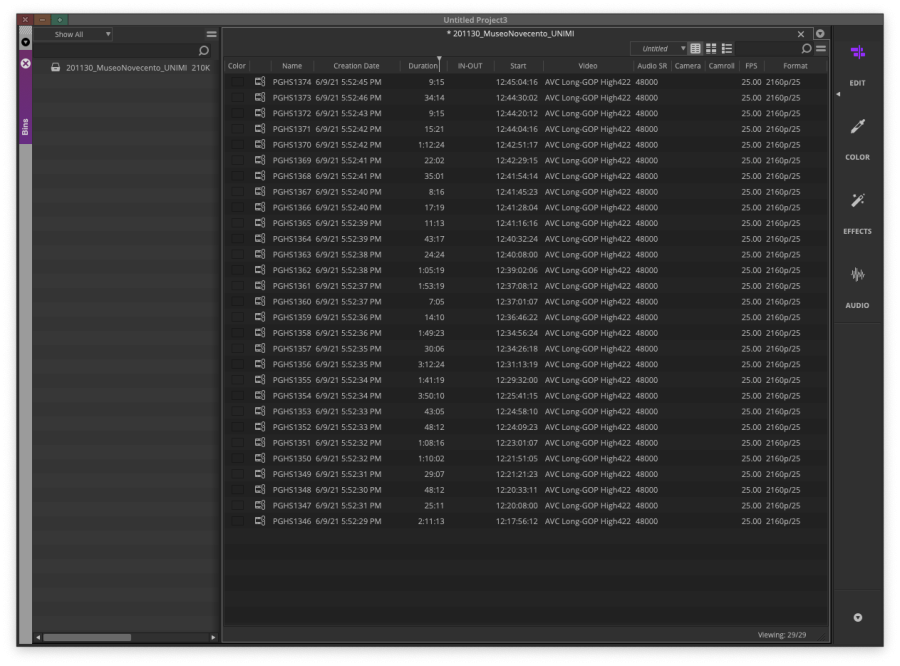
Open the “Options”, then click on “Options…” navigate to the Shot Log tab and select
“Merge events with known master clips”.
Navigate to the ALE file you created before and click “Open”.
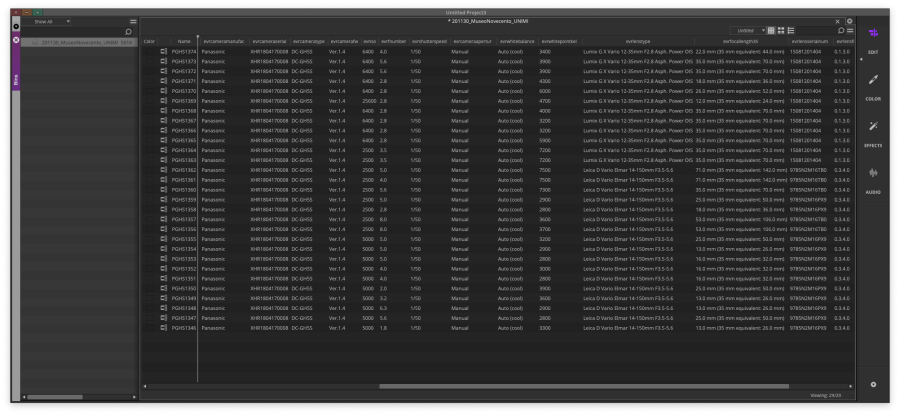
Avid Media Composer now matches master clips and metadata information from the .ale file according to their TimeCode, Bin Name and Name of clip.
The information from the .ale file is attached within additional columns in the bin table. Some of the columns are already known by the Avid Media Composer, all unknown information will be added as custom columns.
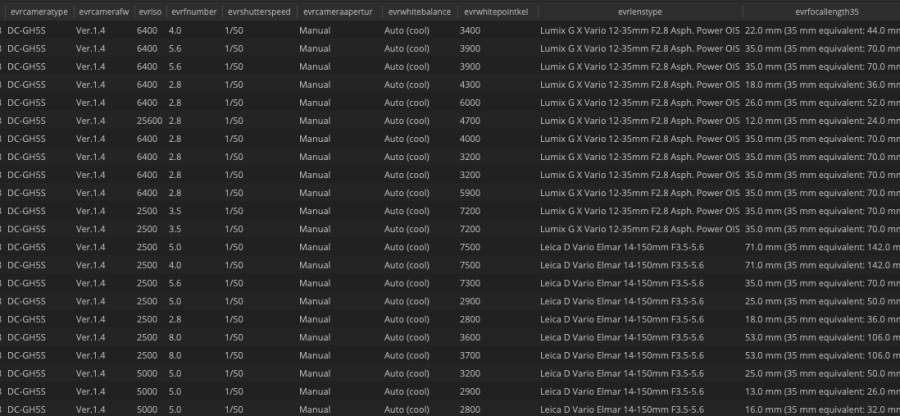
If you cannot see any custom columns, perform the following steps:
- Close and re-open the bin
- Right-click in the free space of the bin window and click on “Choose columns…” in the context menu.
- Then select and unselect columns, the custom columns from the imported .ale file you will find at the end of the list.
How to import CSV file in Silverstack
After having created the .csv file in evrExpanse, go to the Silverstack Composer and import the clips if not done so far.
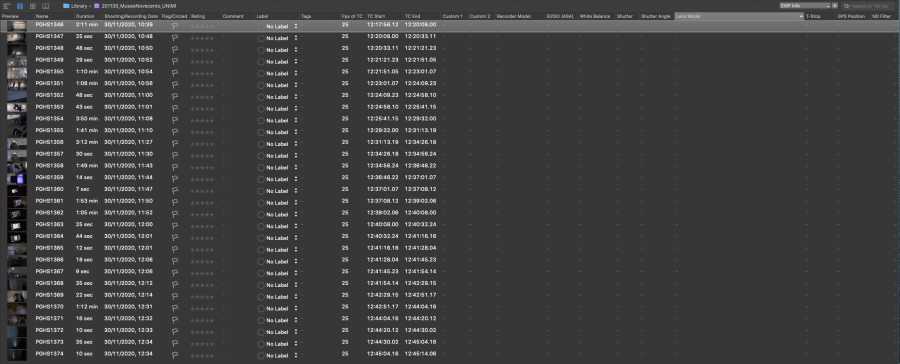
To be able to import metadata evrExpanse will use the Drylab CSV import feature in Silverstack.
Select the folder or bin in the library of Silverstack that you want to import metadata for.
Then, in the “Import” menu button in the toolbar select the option Drylab CSV:
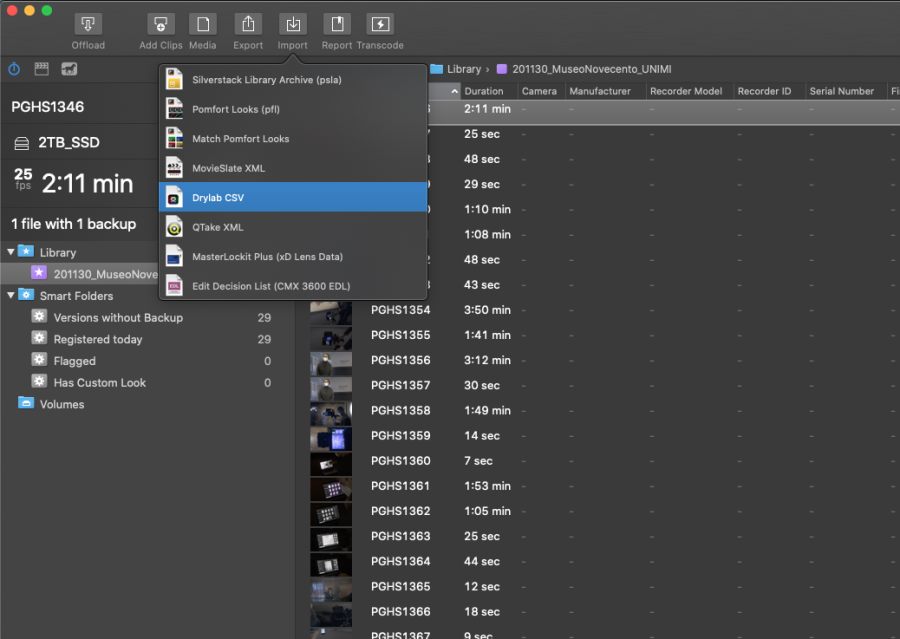
When the Finder dialog points you to select a file, choose the CSV file exported from evrExpanse and select “Open”.
There are two options to match the events in the CSV to the clips in the library:
- by Clip Name
- by Creation Date
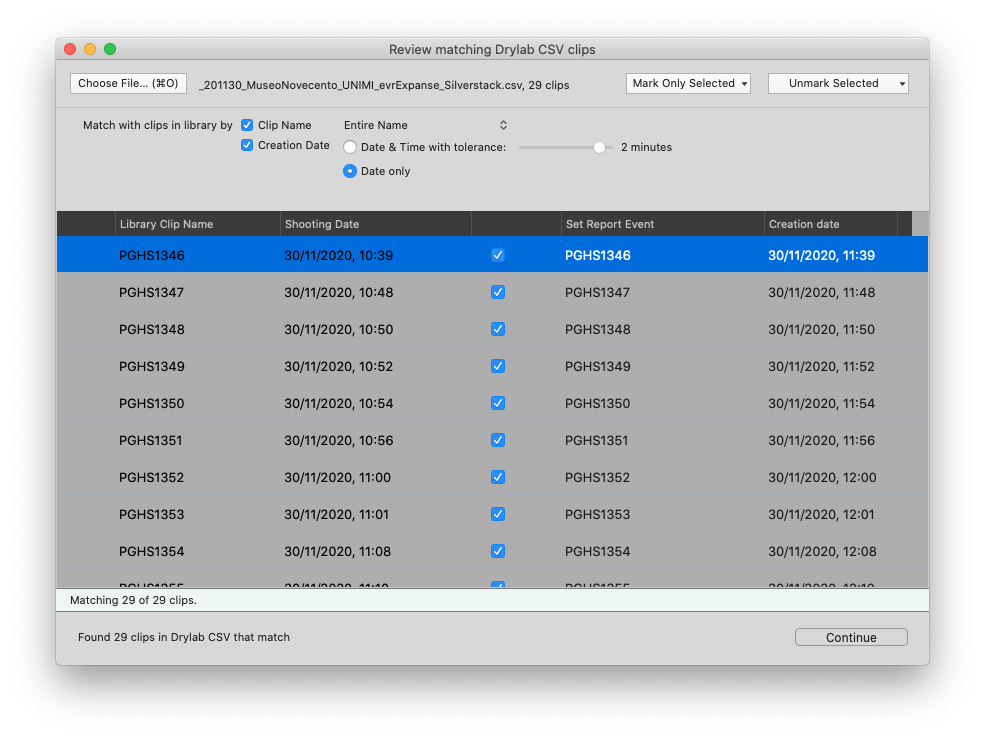
Select Clip Name and Creation Date (Date only) and click “Continue”.
Import Section: In this step you can select or unselect the metadata that should be imported from the CSV to the Silverstack library.
evrExpanse metadata are under the sections:
- Camera Settings
- Lens and Filter
- Comment and Caption
- Append Tags
- Day Number + Day Date (as Custom 1)
Insert/Update Behavior: Choose if you only want to insert new metadata if a fields is empty or you want to force an overwrite.
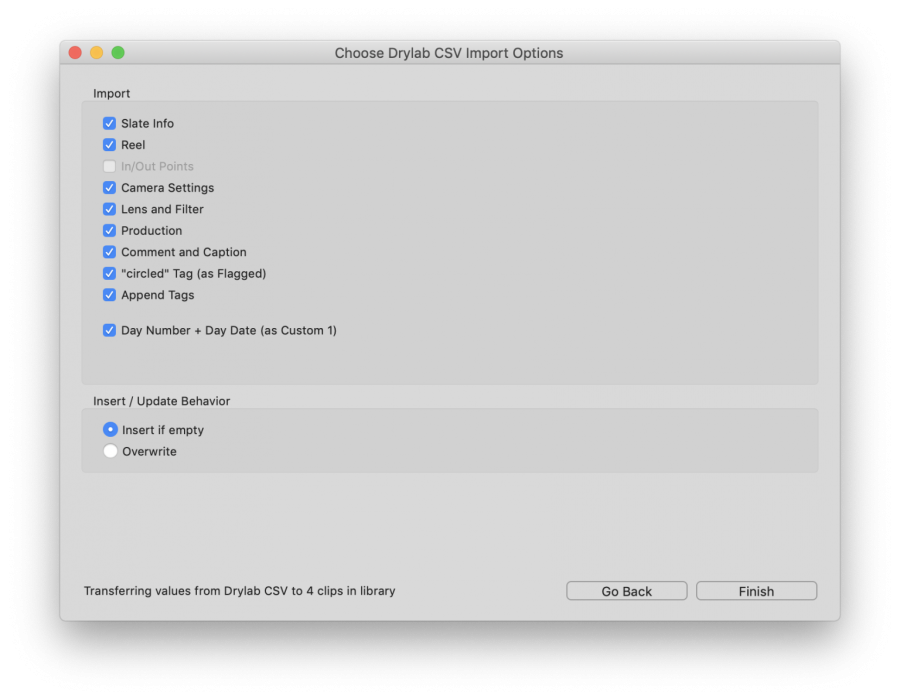
Select the option in bold and click "Finish"
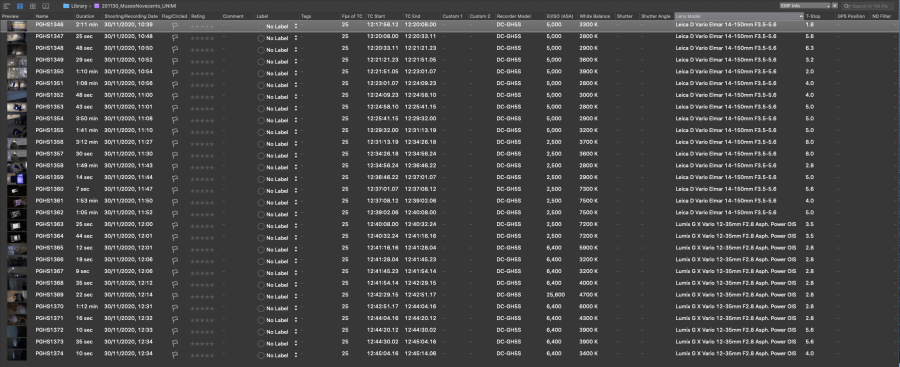
If the media files have been tagged using the macOS Finder Tag, the information will be reported in Tags column in Silverstack.
Canon XF Utility Integration Workflow
📌 Applicable to Canon EOS Cinema cameras prior to the C80 and C400 series, including: C300 / C500 / C200 / C700 / C70 / R5 C and others.
Note: Canon C80 and C400 (2024) embed metadata directly in the MXF files — evrExpanse natively supports those without this integration.
Prerequisites
You can download Canon XF Utility from Canon's official site: https://app.ssw.imaging-saas.canon/app/en/xfu.html
Before starting, ensure the following:
- Canon XF Utility is installed on your macOS system.
- The
.MXFclips are stored in their original folder structure, including theINDEX.MIFfile. - evrExpanse is installed and updated to the latest version.
- You have write permissions to create symlinks if needed.
This workflow outlines how to use Canon XF Utility to generate frame grabs that can be paired with .MXF clips in evrExpanse for enhanced metadata extraction.
1. Open Canon XF Utility
- Launch the Canon XF Utility application.
- Load the card or folder containing your
.MXFfiles.
📌 Important: The
INDEX.MIFfile must be present in the folder. Without it, Canon XF Utility will not recognize or load the clips or metadata.
2. Set Preferences in XF Utility
In the Frame Grab 1 tab:
- File Type: Set to
JPEG - Image Quality: Set to
1 - Folder for Frame Grabs: Set the desired export path. The default is
/Users/username/Documents/Canon/XFUtility/Photo
Note: Metadata is preserved regardless of JPEG image quality.
In the Frame Grab 2 tab:
- File naming is not critical.
- evrExpanse matches frame grabs to clips based on folder structure, not exact filenames.
3. Manually Grab a Frame for Each Clip
- Select each clip in Canon XF Utility.
- Click “Grab a Single Still Frame” at the bottom of the interface.
❗ Canon XF Utility does not support batch frame grab export — this step must be done manually for each clip.
4. Make JPGs Accessible to evrExpanse
Ensure the exported .JPG files are accessible within the Source Folder selected in evrExpanse. You have two options:
Option A: Copy or Move JPGs
- Place the JPGs into any folder or subfolder inside the selected Source Folder.
Option B: Create a Symlink
ℹ️ Note: A symlink (symbolic link) is not the same as a macOS Alias. Symlinks behave like actual folder paths at the system level, which evrExpanse can follow reliably. In contrast, Aliases are macOS-specific pointers that may not work correctly in automated workflows.
- Create a symbolic link of the XF Utility's Folder for Frame Grabs (defined in point 2) and move it into the Source Folder selected in evrExpanse.
- This is a one-time setup if your XF Utility export path remains the same.
- ✅ A Quick Action is available to download to automate this symlink creation.
5. Run Export or Transcode in evrExpanse
- In evrExpanse, select the Source Folder that contains the Canon MXF footage and the actual
.JPGfiles or the symlink folder created in Step 4. - You can now run either the Export Metadata or Transcode process.
The app will:
- Automatically associate
.JPGframe grabs with their corresponding.MXFclips. - Extract enhanced metadata using the matched pairs.
- Embed this enhanced metadata into transcoded files when transcoding is performed.
